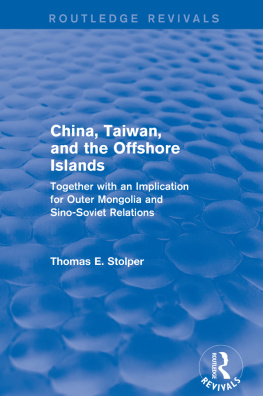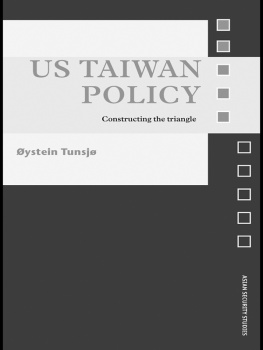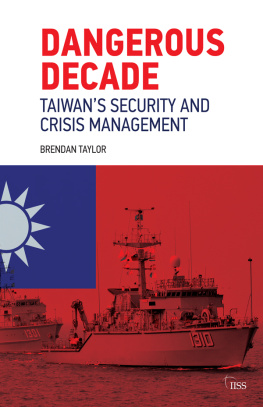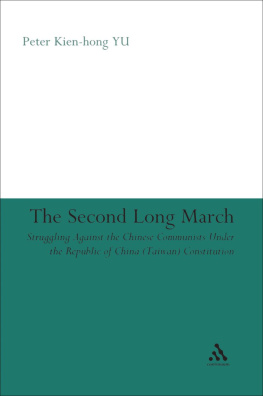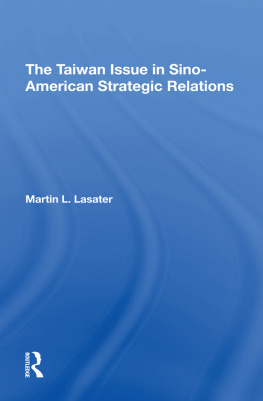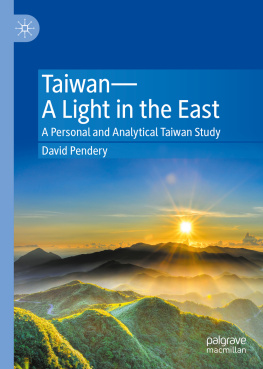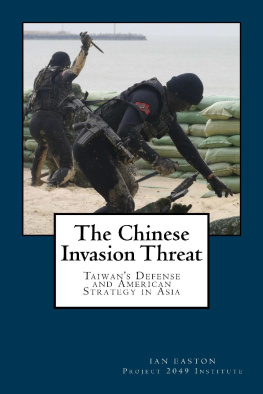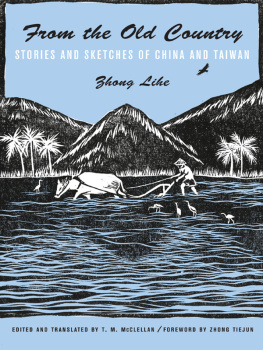CHINA, TAIWAN, AND THE OFFSHORE ISLANDS
China, Taiwan, and the Offshore Islands
Together with an Implication for Outer Mongolia and Sino-Soviet Relations
Thomas E. Stolper
East Gate Books are edited by Douglas Merwin
First published 1985 by M.E. Sharpe
Reissued 2018 by Routledge
2 Park Square, Milton Park, Abingdon, Oxon OX14 4RN
711 Third Avenue, New York, NY 10017, USA
Routledge is an imprint of the Taylor & Francis Group, an informa business
Copyright 1985 by Taylor & Francis
All rights reserved. No part of this book may be reprinted or reproduced or utilised in any form or by any electronic, mechanical, or other means, now known or hereafter invented, including photocopying and recording, or in any information storage or retrieval system, without permission in writing from the publishers.
Notice:
Product or corporate names may be trademarks or registered trademarks, and are used only for identification and explanation without intent to infringe.
Publishers Note
The publisher has gone to great lengths to ensure the quality of this reprint but points out that some imperfections in the original copies may be apparent.
Disclaimer
The publisher has made every effort to trace copyright holders and welcomes correspondence from those they have been unable to contact.
A Library of Congress record exists under LC control number: 84022124
ISBN 13: 978-1-138-89530-0 (hbk)
ISBN 13: 978-1-138-89522-5 (pbk)
ISBN 13: 978-1-315-49533-0 (ebk)
TO MY PARENTS AND GRANDPARENTS
This book originated in a seminar taught by Allen S. Whiting and has benefited from his criticism. Tang Tsou allowed me to compare a draft with his unpublished manuscript on the same topic, Roy Grow, Jonathan Pollack, Richard Ford, and William Ascher commented on other drafts. Ralph Clough wrote a helpful critique. Michel Oksenberg commented on the penultimate draft, and, along with Edward Friedman and John Gittings, provided stimulation and encouragement in the middle stages of the work. Gerard O. Forcier of the State Department did yeoman work in declassification. The University of Michigan Center for Chinese Studies acted as a catalyst, and several units of the university library were helpful throughout. The staffs of the Firestone Library and the Mudd Library at Princeton, of Butler Library at Columbia, and of the Eisenhower Library in Abilene, Kansas, guided the author to highly useful research materials. My father, Wolfgang F. Stolper, and grandmother, Mrs. Antonie Stolper, provided financial support. Katherine Davis drew the map. All contributed to whatever strengths this book may have, and none is responsible for any errors or weaknesses which may remain.
Thomas E. Stolper
Ann Arbor
- ADIZ Air Defense Identification Zone
- ANZUS Australia-New Zealand-United States
- CCP Chinese Communist Party
- CINCPAC Commander-in-Chief, U.S. Forces in the Pacific
- DP John Foster Dulles, Papers, 19521959, Eisenhower Library, Abilene, Kansas
- DSB Department of State Bulletin
- FBIS Foreign Broadcast Information Service
- FRUS Foreign Relations of the United States
- FY Fiscal Year
- GRC Government of the Republic of China (Taipei)
- JCS Joint Chiefs of Staff
- JPRS Joint Publications Research Service
- KMT Kuomintang
- LST Landing Ship, Tanks
- MAAG Military Assistance Advisory Group
- MDT Mutual Defense Treaty
- NCNA New China News Agency
- NEATO Northeast Asian Treaty Organization
- NSC National Security Council
- NYT New York Times
- PL A People's Liberation Army
- PRC People's Republic of China (Peking)
- RMRB Renmin Ribao ( People's Daily )
- ROC Republic of China (Taipei)
- ROK Republic of Korea (Seoul)
- SCMP Survey of the China Mainland Press
- SEATO Southeast Asian Treaty Organization
- TRA Taiwan Relations Act
- WF Dwight D. Eisenhower, Papers as President of the United States, 19531961 (Ann Whitman File), Eisenhower Library, Abilene, Kansas.
China, Taiwan, and the Offshore Islands
I
The Analytical Framework
"Look for the invariants."
"One of the principal objects of theoretical research in any department of knowledge is to find the point of view from which the subject appears in its greatest simplicity."
In September 1954, January-March 1955, and August-October 1958, it seemed as if the United States of America and the People's Republic of China might go to war over a few small islands lying off the China coast. The purpose of this book is to explain how and why such an impression arose. The theme of the work is that Peking was striving to defend its sovereignty and territorial integrity, shows that the 1958 Taiwan affair was both a sequel to the earlier affair and another episode in the same struggle; and a final chapter expands on the analogy with Outer Mongolia.
In constructing a framework for the analysis of the events involved, one can usefully combine elements from the work of several scholars in the fields of international politics, foreign policy analysis, and Chinese foreign policy.
We begin with the 1954-55 affair, a dispute between two hostile powers which did not have diplomatic relations with each other and which had only a tenuous contact in the form of intermittent talks at the consular level about the very limited subject of nationals detained in each other's countries. Communication by action provides particularly useful benchmarks, for action was often the only way Peking could get Washington's attention. Those actions were of two main kinds: attacks on the islands held by the Nationalists just off the mainland of China, and the release or sentencing of Americans held in the PRC. Peking also kept a close watch on actions by Washington, which used maneuver by American forces, the unleashing or reining in of Nationalist forces, and the release or detention of Chinese citizens as a form of communication.
Though the 1954-55 Taiwan affair was one of the few post-World War II incidents to involve both American nuclear threats and the deployment of more than three U.S. Navy carrier task forces, and away from the primary question of Taiwan.
Events on the international scene may not occur because of rational choice by a unitary actor in pursuit of well-defined ends (Model I) but rather as the automatic result of organizational process (Model II) or as the result of pulling and hauling among the bureaucracies within the government of each national actor (Model III).
Model II is useful in analyzing the fine structure of a problem, but we are concerned more with outlines. Model II is useful in analyzing the behavior of general actors such as "the PRC" and "the U.S.," because it helps one see how decisions made at higher levels are modified in their execution at lower levels of the same broader unit; but as events unfolded, both Peking and Washington supervised operational details in the area of Taiwan more closely. Therefore, puzzles about them are less likely to be solved by focusing on the semiautonomous behavior of organizations. In addition, though there were many small incidents of a nonviolent nature between the forces of the two powers, e.g., American aerial intrusions and subsequent retreats when PRC planes rose to meet them, there was no equivalent to the interaction of the U. S. and Soviet fleets in the Mediterranean and the consequent need to regulate and mesh Standard Operating Procedures (SOPs) in order to avert disaster.

